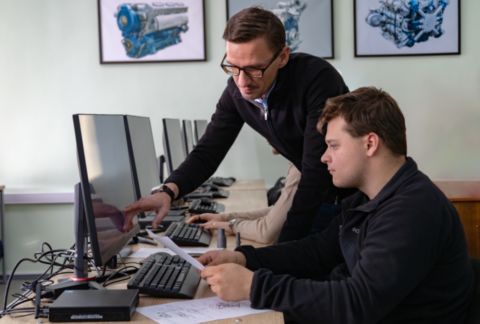Scientists from South Ural State University are developing technical solutions for creating a Russian high-speed industrial gas piston engine with dimensions of 18.5/21.5, which will be used in transport (quarry dump trucks, railway locomotives) and as a source for small-scale energy generation (up to 5 MW).
Today, staff members of the Department of Combustion Engines and “The Heart of the Urals” Advanced Engineering School of SUSU are at the stage of researching the workflow, developing and manufacturing of prototypes of new components, which will subsequently be tested as part of an experimental prototype of a full-size engine.
The gas piston engine with dimensions of 18.5/21.5 under development is included in the model range of the DM-185 family of high-speed diesel engines with the number of cylinders from 6 to 20 in the power range from 500 kW to 5000 kW.
In particular, the 12-cylinder locomotive modification of the high-speed gas piston engine with a power of 1600 kW under development will be installed on the heavy shunting and haulage diesel locomotive TEMG7 for operation on the railway tracks of PAO Gazprom. Since the import of such engines from Western countries to Russia has become impossible at present, the Ural Diesel Engine Plant (UDMZ) has activated the program of import substitution and technical re-equipment of its own production. The plant asked SUSU scientists for assisting in developing the Russian gas piston engine.
“We are designing a gas engine based on a diesel one,” says Head of the SUSU Department of Combustion Engines Aleksandr Popov. “Such an engine, depending on the field of its application, whether at a power plant or on quarry equipment, does not differ much in design. The main difference lies in changing the settings of the electronic control system. Also, depending on the climatic factor, for hot and cold regions, the parameters of auxiliary units and systems can change. In general, the problem of the availability of internal combustion engines of this class in Russia is now extremely relevant. Since the early 2000s, industrial gas piston engines (for example, as part of engine-generator units) have been purchased abroad in large quantities. According to the latest estimates, more than two and a half thousand units have been imported, and today these engines are already beginning to reach the end of their service life. Therefore, our task is to develop a Russian analogue together with the plant as soon as possible, to replace foreign models. When designing technical solutions, we try to come up with the simplest and most reliable design solutions.”
The Ural Diesel Engine Plant is planning to engineer an experimental model of a full-size 12-cylinder engine in a gas modification by the end of 2025 to conduct a series of bench tests in factory conditions.
“The project for developing a Russian gas piston engine incorporates all the latest global developments in this area,” says project manager of the Ural Diesel Engine Plant Sergey Nefedov. “For example, the fuel supply system will use an electronically controlled distributed gas supply to each of the 12 cylinders, while most foreign analogues traditionally use a centralized (or mono-) fuel supply at the inlet to the turbocharger. The new approach promotes safe gas distribution and high-quality regulation of the mixture composition among the cylinders depending on the specified mode. This will save fuel and reduce the content of toxic components in the exhaust gases of the engine.”
Such a high-speed engine can be used as an auxiliary power unit on civil ships of various purposes. In small-scale power engineering, these are gas piston mobile and stationary power plants that supply electricity to gas and oil fields, remote residential areas and technical facilities located in the Arctic and Far North regions; or they operate to drive various types of technological equipment, such as compressor stations.
The project on the “Development of Gas Piston Engines with Dimensions of 18.5/21.5” is being implemented within the frameworks of the World-class Ural Interregional Research and Education Centre (Science and Universities national project). In 2022, this Research and Education Centre was among the winners in the competitive selection for subsidies for the implementation of scientific and technical projects included in the list of the Ural REC from the Government of the Chelyabinsk Region.




